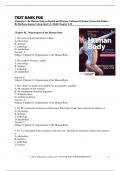Test Bank for
Memmler's the Human Body in Health and Disease, Enhanced Edition Fourteenth Edition
By Barbara Janson Cohen, Kerry L. Hull Chapter 1-25
Chapter 01: Organization of the Human Body
1. The study of body functions is called
A. physiology
B. anatomy
C. pathology
D. metabolism
Answer: A
Subject: Chapter 01: Organization of the Human Body
2. The study of disease is called
A. physiology
B. anatomy
C. pathology
D. metabolism
Answer: C
Subject: Chapter 01: Organization of the Human Body
3. The subject of study most suitable for an anatomist would be
A. the structure of the stomach
B. the mechanism of protein digestion
C. stomach cancer
D. anabolic reactions
Answer: A
Subject: Chapter 01: Organization of the Human Body
4. Dr. M is interested in diseases of the retina. The field of study best suited to his interests is
A. physiology
B. anatomy
C. pathology
D. metabolism
Answer: C
Subject: Chapter 01: Organization of the Human Body
5. Dr. C is interested in the structure of the inner ear. The field of study best suited to her interests
is
A. physiology
B. anatomy
C. pathology
D. surgery
© Jones & Bartlett Learning, LLC. NOT FOR SALE OR DISTRIBUTION 1-1
,Answer: B
Subject: Chapter 01: Organization of the Human Body
6. The correct order of body organization from simplest to most complex is
A. organ, tissue, cell, organism, system
B. cell, tissue, organ, system, organism
C. system, cell, organ, organism, tissue
D. cell, system, tissue, organ, organism
Answer: B
Subject: Chapter 01: Organization of the Human Body
7. The system that transports blood to and from body cells is the
A. integumentary system
B. skeletal system
C. respiratory system
D. cardiovascular system
Answer: D
Subject: Chapter 01: Organization of the Human Body
8. The system composed of bones and joints is the
A. skeletal system
B. nervous system
C. lymphatic system
D. muscular system
Answer: A
Subject: Chapter 01: Organization of the Human Body
9. The body systems involved in communication and control are the
A. lymphatic and urinary
B. respiratory and digestive
C. nervous and endocrine
D. integumentary and reproductive
Answer: C
Subject: Chapter 01: Organization of the Human Body
10. The components of a negative feedback system in correct order of function are
A. thermostat, furnace, electric signal
B. set point, control center, heat output
C. cooling mechanism, effector, sensor
D. sensor, control center, effector
Answer: D
Subject: Chapter 01: Organization of the Human Body
11. Which example demonstrates the principle of negative feedback?
A. A decrease in blood sugar stimulates the release of a hormone that further decreases blood
sugar.
© Jones & Bartlett Learning, LLC. NOT FOR SALE OR DISTRIBUTION 1-2
,B. A decrease in room temperature activates a thermostat, which further decreases heat output by a
furnace.
C. A rise in blood calcium levels stimulates the release of a hormone that lowers blood calcium
levels.
D. A rise in estrogen levels stimulates the production of a hormone that stimulates estrogen
production.
Answer: C
Subject: Chapter 01: Organization of the Human Body
12. Which example does NOT demonstrate the principle of homeostasis?
A. A rise in plasma sodium stimulates the release of a hormone that increases sodium loss in the
urine.
B. The activation of a clotting factor stimulates the production of the enzyme that activates the
clotting factor.
C. An increase in plasma volume increases urination.
D. An increase in body temperature induces sweating, which reduces body temperature.
Answer: B
Subject: Chapter 01: Organization of the Human Body
13. The thin, moist barrier that protects the digestive tract is the
A. integumentary membrane
B. plasma membrane
C. mucous membrane
D. gradient membrane
Answer: C
Subject: Chapter 01: Organization of the Human Body
14. At the microscopic level, the barrier that separates the internal environment of the cells from
their external environment is the
A. integumentary membrane
B. plasma membrane
C. mucous membrane
D. gradient membrane
Answer: B
Subject: Chapter 01: Organization of the Human Body
15. A difference in specific physical or chemical values between two areas is called a
A. barrier
B. effector
C. plane
D. gradient
Answer: D
Subject: Chapter 01: Organization of the Human Body
16. The term that means farther from the midline of the body is
A. sagittal
© Jones & Bartlett Learning, LLC. NOT FOR SALE OR DISTRIBUTION 1-3
, B. lateral
C. distal
D. transverse
Answer: B
Subject: Chapter 01: Organization of the Human Body
17. The term that describes the position of the stomach with respect to the lungs is
A. medial
B. anterior
C. dorsal
D. inferior
Answer: D
Subject: Chapter 01: Organization of the Human Body
18. The term that describes the position of the hypogastric region of the abdomen with respect to
the iliac region is
A. medial
B. anterior
C. lateral
D. dorsal
Answer: A
Subject: Chapter 01: Organization of the Human Body
19. The term that best describes the position of the elbow with respect to the hand is
A. medial
B. anterior
C. proximal
D. inferior
Answer: C
Subject: Chapter 01: Organization of the Human Body
20. The term that means nearer to the back is
A. ventral
B. superior
C. anterior
D. dorsal
Answer: D
Subject: Chapter 01: Organization of the Human Body
21. A plane that divides the body into superior and inferior parts is the
A. sagittal plane
B. transverse plane
C. frontal plane
D. coronal plane
© Jones & Bartlett Learning, LLC. NOT FOR SALE OR DISTRIBUTION 1-4




